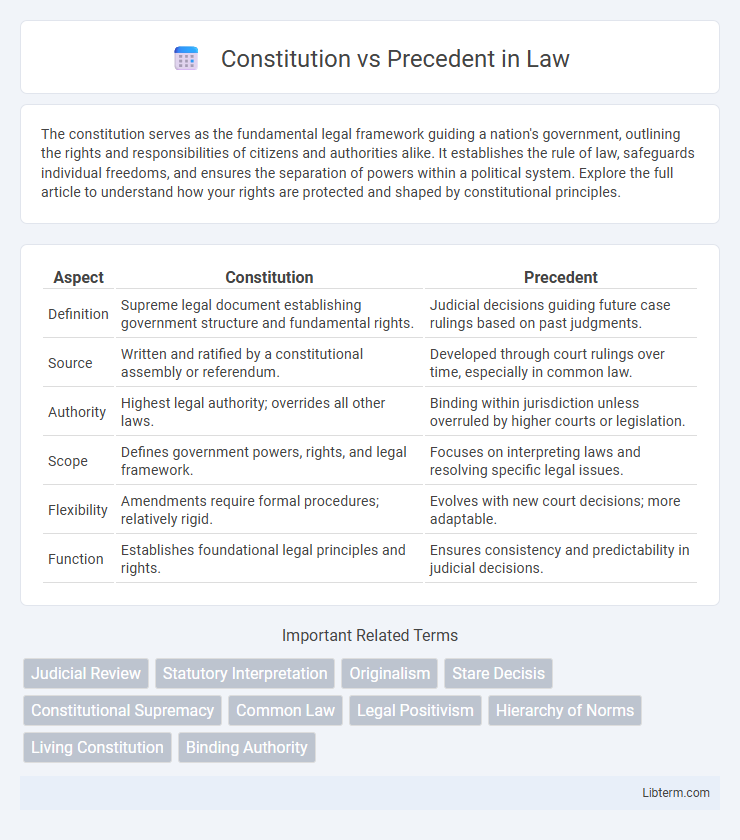The constitution serves as the fundamental legal framework guiding a nation's government, outlining the rights and responsibilities of citizens and authorities alike. It establishes the rule of law, safeguards individual freedoms, and ensures the separation of powers within a political system. Explore the full article to understand how your rights are protected and shaped by constitutional principles.
Table of Comparison
| Aspect | Constitution | Precedent |
|---|---|---|
| Definition | Supreme legal document establishing government structure and fundamental rights. | Judicial decisions guiding future case rulings based on past judgments. |
| Source | Written and ratified by a constitutional assembly or referendum. | Developed through court rulings over time, especially in common law. |
| Authority | Highest legal authority; overrides all other laws. | Binding within jurisdiction unless overruled by higher courts or legislation. |
| Scope | Defines government powers, rights, and legal framework. | Focuses on interpreting laws and resolving specific legal issues. |
| Flexibility | Amendments require formal procedures; relatively rigid. | Evolves with new court decisions; more adaptable. |
| Function | Establishes foundational legal principles and rights. | Ensures consistency and predictability in judicial decisions. |
Introduction: Defining Constitution and Precedent
The Constitution serves as the supreme legal framework outlining the fundamental principles and structure of government, while precedent refers to prior judicial decisions that guide future case law. Constitutions are typically codified documents providing the foundational rules and rights, whereas precedents evolve through court interpretations and applications over time. Understanding the distinction between these two helps clarify the sources of legal authority and the mechanisms of law development.
Historical Origins of Constitutional Law
Constitutional law originates from foundational documents like the Magna Carta of 1215 and the U.S. Constitution of 1787, establishing structured governance and fundamental rights. Precedent, or case law, derives from judicial decisions interpreting these constitutional texts over time, shaping legal principles through court rulings. The historical development of constitutional law reflects a balance between written statutes and evolving judicial interpretations.
The Role of Precedent in Legal Systems
Precedent plays a critical role in legal systems by ensuring consistency and predictability in judicial decisions through the doctrine of stare decisis. Courts rely on prior rulings to interpret ambiguous constitutional provisions, thereby bridging gaps where statutes are silent or unclear. This practice supports the Constitution's authority while allowing legal principles to evolve with societal changes and judicial reasoning.
Constitutional Supremacy Explained
Constitutional supremacy establishes the constitution as the highest legal authority, overriding any conflicting laws or judicial precedents. This principle ensures that all legislative acts and case decisions conform to constitutional mandates, maintaining the rule of law and safeguarding fundamental rights. Courts must invalidate any precedent or statute that contradicts constitutional provisions, reinforcing the constitution's ultimate authority in the legal hierarchy.
Precedent: Stare Decisis Principle
The principle of stare decisis mandates courts to follow established precedents to ensure legal consistency and predictability. This doctrine reinforces judicial decisions by obligating lower courts to adhere to the rulings of higher courts within the same jurisdiction. Stare decisis anchors the rule of law by maintaining continuity and stability in legal interpretation over time.
Interactions Between Constitution and Precedent
The Constitution serves as the supreme legal framework, while precedent interprets and applies its principles in specific cases, creating a dynamic relationship. Courts rely on precedent to ensure consistency and stability in constitutional law, yet landmark rulings can also reshape constitutional understanding over time. This interaction ensures that constitutional meaning evolves with societal changes while maintaining foundational legal authority.
When Precedent Conflicts with Constitutional Principles
When precedent conflicts with constitutional principles, courts must prioritize the Constitution as the supreme law of the land, ensuring that all legal interpretations align with its text and intent. Judicial review enables courts to overturn precedents that violate fundamental rights or constitutional provisions, preserving the integrity of constitutional governance. This process safeguards against the perpetuation of outdated or unconstitutional rulings, reinforcing the primacy of constitutional supremacy in legal systems.
Judicial Review: Balancing Constitution and Precedent
Judicial review serves as the mechanism through which courts interpret the Constitution while evaluating the applicability of precedent, ensuring legal consistency and constitutional fidelity. Courts analyze prior decisions against constitutional principles to determine when precedent should be upheld or overruled, maintaining a dynamic balance between evolving legal standards and foundational constitutional mandates. This balance protects the rule of law by preserving stability through precedent, yet allows constitutional interpretation to adapt to contemporary challenges.
Impact on Legal Interpretation and Reform
The Constitution establishes the fundamental legal framework and supreme law guiding judicial decisions, while precedent shapes legal interpretation through past rulings that courts rely on for consistency. Precedent provides practical application and adaptability, influencing incremental reform by interpreting constitutional principles in evolving contexts. Variations between constitutional text and precedent-driven interpretations often drive legal debates and reforms aimed at harmonizing foundational law with contemporary societal needs.
Conclusion: Evolving Relationship Between Constitution and Precedent
The evolving relationship between the Constitution and precedent reflects a dynamic balance where constitutional principles provide a foundational framework while precedent ensures practical application in changing contexts. Courts continuously interpret the Constitution through precedent, adapting to societal shifts without undermining original constitutional intent. This interplay fosters legal stability alongside necessary flexibility, reinforcing the Constitution's enduring relevance.
Constitution Infographic

 libterm.com
libterm.com